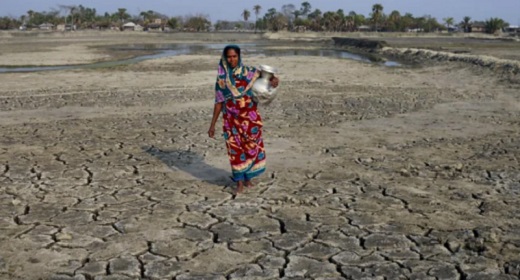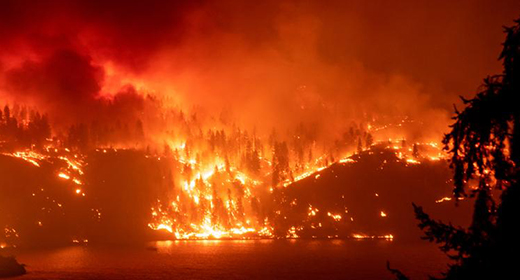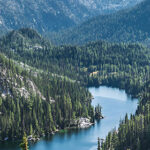by Sam Baker: What really makes this reporter’s stomach churn thinking about climate change?
Thawing permafrost. A scenario where it all melts, releasing copious amounts of CO2 and methane (it holds twice as much carbon as the atmosphere holds right now), and there’s no going back.
But what’s at the top of the list of concerns for those who study how climate change is unfolding – on ice sheets and urban street corners, in oceans and farm fields – the climate scientists themselves?
DW asked a dozen experts spanning climatology, entomology, oceanography and yes, permafrost research, what keeps them up at night when it comes to the climate.
The Greatest Unknown – People
Nana Ama Browne Klutse studies changing weather with climate models at the University of Ghana. While she says tipping points like permafrost thaw worry her, she also worries how individuals will handle changing climates.
“What can you do as an individual to avoid the impact of climate change?” she asked. “We need government policies for resilience, building of community, city resilience. Then we need that global action.”
Climate scientist Ruth Mottram studies the Greenland and Antarctic ice sheets and sea level rise for the Danish Meteorological Institute, but it’s not the science that worries her.
“I’m less concerned that there are unknown processes going on that we don’t understand, and there could potentially be some unforeseen catastrophe on the way,” she said. “We know what a lot of the impacts are going to be. I think what keeps me awake at night in a metaphorical sense is really the interaction between the physical system and how human societies are going to handle it.”
Giving the example of sea level, she says we will see a meter rise this century — in our lifetimes or that of our children — and will have to make tough decisions about our coastal cities. But she says it won’t end there.
“I think that human societies have not really grasped what that means and that adaptation to sea level rise is going to be a long process and we are going to be doing it for hundreds of years,” said Mottram, suggesting that we start thinking in terms of the lifetimes of cities (hundreds of years) rather than just human lifetimes.
Protecting the Vulnerable
Vladimir Romanovsky, a professor of geophysics at the University of Alaska Fairbanks’ Permafrost Laboratory, said that while he thinks about how what happens in the Arctic will affect the rest of the world, his concerns are much more local.
“We should remember that there are still some people living in the Arctic,” he said. Around 4 million people in fact who would have to deal with the real-life consequences of solid ground thawing beneath their feet and houses. “Changes in these local or regional kind of climates and environments, they impact these people and some of these impacts could be very severe.”
Closer to the planet’s other pole, Carolina Vera fears that existing inequalities will only be exacerbated by climate change.
“Climate change is already impacting the most vulnerable sectors of our planet,” said Vera, who studies climate variability as a principal researcher for the National Council of Science of Argentina, a professor at the University of Buenos Aires and chief of staff for Argentina’s Ministry of Science and Technology. Her work has led her to incorporate local knowledge and data collection into studies, involving communities that are balancing the problems of deforestation with their need to farm.
Heat and New Extremes
Perhaps not surprisingly, global heating is a key concern for many researchers, like Dim Coumou, who studies extreme weather at Vrije Universiteit Amsterdam.
Of most concern to him are heat and humidity extremes in the tropics – especially highly populated parts like West Africa, Pakistan and India – which will make it unbearable to be outside. When cooling down by sweating is no longer possible, people can’t work outside and therefore can’t grow food. The likely result being mass migration.
But it’s not just the tropics.
Closely related to heat is the increase in extreme weather brought on by a warming climate. Coumou and his colleagues’ research shows how changes to the jet stream will lead to more extreme weather in Europe, including floods and droughts.
This increase in extreme weather is climate scientist Abubakr Salih Babiker’s biggest climate concern.
“A warmer atmosphere can hold more water in it and when it rains, it rains heavily leading to floods. A warmer ocean can lead to stronger tropical cyclones,” said Babiker, who works for the East African Climate Center ICPAC in Nairobi. He explained that cyclones gain more energy from warmer water.
“We have seen evidence of all these events,” he said. “The strongest tropical cyclones to impact the Arabian Peninsula, Somalia, and Mozambique occurred in the past 20 years!”
And extreme weather events can bring further ecological disasters along with them, like swarms of locusts, as Babiker and his colleagues have found in their research.
Science for Solutions
Pests, drought and flooding are on Esther Ngumbi’s mind too.
An entomologist and professor of African American studies at the University of Illinois at Urbana-Champaign, she said that what keeps her up at night is the thought: “How can my science truly help?”
Ngumbi’s work on pest and drought-resistant crops is driven by her concerns for vulnerable farmers who live in countries lacking social safety nets, where one season of crop devastation due to insects can mean going hungry and being unable to pay for their children’s education.
“That truly makes me wake up every day and go to the lab to understand how my research can contribute to solutions that we need,” she said.
Natasha Picone – an urban climatologist at the National University of Central Buenos Aires – says it’s the solutions that occupy her thoughts too.
“With the pandemic, I realized that we are not doing enough for changing our cities to be more livable,” she said. Her research informs urban planners about phenomena such as the urban heat island effect, air pollution and urban run-off that can lead to flooding. “If we don’t change the path now, it will be really difficult to go back.”
Weighing on the mind of oceanographer Renata Hanae Nagai at the University of Parana in Brazil is her four-year-old nephew and what his life will look like in a warmer world, but he also gives her hope. During a recent trip to the beach to watch nesting turtles, he warned others to leave the turtles alone.
She sees this same care in her students – learning about problems and coming up with solutions.
“People are the solution,” she said. “We try, even under the hardest conditions.”
‘Scientists are Humans’ Too
Levke Caesar, whose research recently made headlines, said the most concerning thing for her is the people and organizations who deny climate change.
“For me, that’s like morally totally unacceptable what they do – they lie,” said the climate physicist from Maynooth University in Ireland, reflecting on encountering such people at public talks. “I mean, you can’t argue with climate.”
But this only pushes Caesar to better communicate what the science shows.
They Worry About Us
A common thread of this (rather unscientific) survey is that while we laypeople might be worrying about what the science says, climate scientists are often worrying about us.
“Scientists always think about what are the results of their studies, how are they important for, you know, for usual people, for normal people,” the permafrost scientist told me. While doing his research, Romanovsky said he’s always thinking about “how this could be used to make life of people easier or more predictable.”
Source: Eco Watch










































